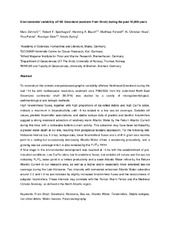Environmental variability off NE Greenland (western Fram Strait) during the past 10,600 years
Permanent link
https://hdl.handle.net/10037/20568Date
2020-08-13Type
Journal articleTidsskriftartikkel
Peer reviewed
Author
Zehnich, Marc; Spielhagen, Robert F.; Bauch, Henning A.; Forwick, Matthias; Hass, Christian; Palme, Tina; Stein, Ruediger; Syring, NicoleAbstract
To reconstruct the climatic and paleoceanographic variability offshore Northeast Greenland during the last ~10 ka with multidecadal resolution, sediment core PS93/025 from the outermost North-East Greenland continental shelf (80.5°N) was studied by a variety of micropaleontological, sedimentological and isotopic methods. High foraminiferal fluxes, together with high proportions of ice-rafted debris and high Ca/Fe ratios, indicate a maximum in bioproductivity until ~8 ka related to a low sea-ice coverage. Sortable silt values, planktic foraminifer associations, and stable isotope data of planktic and benthic foraminifers suggest a strong westward advection of relatively warm Atlantic Water by the Return Atlantic Current during this time, with a noticeable bottom current activity. This advection may have been facilitated by a greater water depth at our site, resulting from postglacial isostatic depression. For the following mid-Holocene interval (ca. 8–5 ka), isotope data, lower foraminiferal fluxes and a shift in grain size maxima point to a lasting but successively decreasing Atlantic Water inflow, a weakening productivity, and a growing sea-ice coverage which is also revealed by the PIIIIP25 index. A final stage in the environmental development was reached at ~5 ka with the establishment of pre-industrial conditions. Low Ca/Fe ratios, low foraminiferal fluxes, low sortable silt values and the sea-ice indicating PIIIIP25 index point to a limited productivity and a weak Atlantic Water inflow by the Return Atlantic Current to our research area, as well as a higher and/or seasonally more extended sea-ice coverage during the Late Holocene. Two intervals with somewhat enhanced Atlantic Water advection around 2.0 and 1.0 ka are indicated by slightly increased foraminiferal fluxes and the reoccurrence of subpolar foraminifers. These intervals may correlate with the Roman Warm Period and the Medieval Climate Anomaly, as defined in the North Atlantic region.
Publisher
SageCitation
Zehnich, Spielhagen RF, Bauch HA, Forwick M, Hass C, Palme, Stein R, Syring. Environmental variability off NE Greenland (western Fram Strait) during the past 10,600 years. The Holocene. 2020;30(12):1752-1766Metadata
Show full item recordCollections
Copyright 2020 The Author(s)


 English
English norsk
norsk